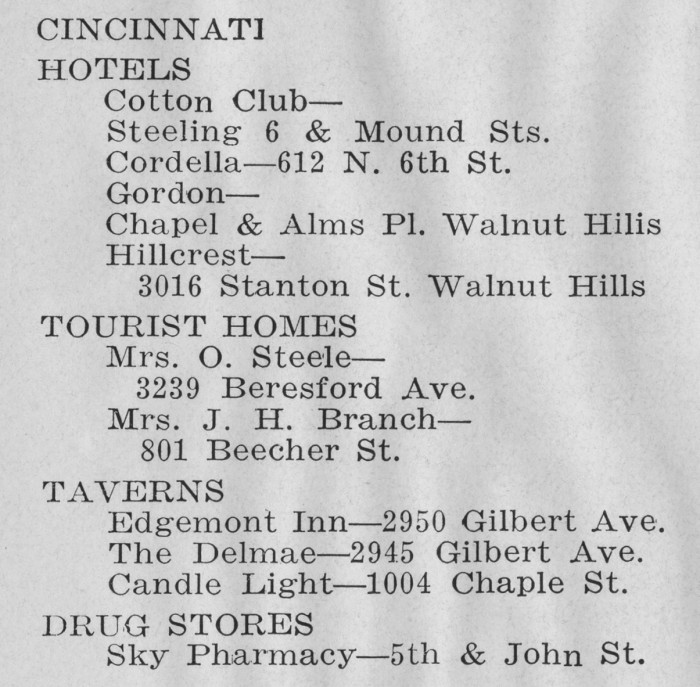African-American travelers in the 1930s faced obstacles utterly unknown to white Americans. Basic information, or the lack of it, could mean the difference between safety and danger. The situation was described in the most euphemistic terms by Victor H. Green, who published a guidebook to assist African-American travelers:
“With the introduction of this travel guide in 1936, it has been our idea to give the Negro traveler information that will keep him from running into difficulties, embarrassments, and to make his trips more enjoyable.”
The “embarrassments” Green refers to could include very serious consequences if an African-American traveler attempted to gain entry to a whites-only hotel or restaurant. Rudeness and shabby treatment were the least an African-American could expect, even in supposedly integrated Northern states like Ohio.
Victor Green’s guidebook was titled The Negro Motorist Green Book. Green, a New York City mail carrier who later went into business as a travel agent, launched the book in 1936 as a guide to the New York City region. He soon expanded nationwide, and the book became essential for African-American travelers. In 1942, journalist Carey McWilliams reported in the Antioch Review:
“In order to travel in the United States today, American Negroes annually purchase 15,000 copies of The Negro Motorist Green Book so that they may know where they can get a room in which to sleep, where they can find a restaurant to get a meal, and where they can find a barber shop in which to get a haircut.”

Digitized by Schomburg Center For Research In Black Culture, New York Public Library
Often, the choices were slim. For Cincinnati, the 1939 edition lists only four hotels, two “tourist homes” (what we might call bed-and-breakfasts), three taverns, and a single drug store that would welcome African-American customers. Two of the hotels were located in the West End and two in Walnut Hills. The West End accommodations included the Sterling Hotel, with its legendary Cotton Club.
Also located in the West End was the Cordelia Hotel, owned by Cordelia L. Wise, who was active in mobilizing black voters to turn out during elections.
In Walnut Hills was the Gordon Hotel at the corner of Chapel Street and Ashland Avenue, built by Cincinnati millionaire Jacob C. Schmidlapp, as part of a personal anti-poverty program that he called “philanthropy plus 5%.” According to the WPA Guide to Cincinnati:
“In 1916, upon learning that locally there were no hotel accommodations for Negroes, Schmidlapp built the Gordon Hotel for them. During the Depression years it lost money, and in 1935 the hotel rooms were remodeled into apartments.”
Curiously, the fourth hotel listed—the Hillcrest Hotel at 3016 Stanton—seems to be listed in error. From the 1920s to the 1940s, 3016 Stanton in Walnut Hills was a private residence. No city directories list a Hillcrest Hotel at all.
Green, of course, in those pre-Google days, relied on communication from his subscribers that was often inaccurate or out-of-date. For example, Green did not include Howard Sudduth’s renowned Manse Hotel on Chapel Street in Walnut Hills until his guide’s fourth edition. The Manse Hotel, built around a boarding house formerly known as the Hotel Terry, accommodated African-American visitors to Cincinnati for decades. Most of the touring African-American musicians stayed there, as did all the black athletes.

Photo of the Manse Hotel, Walnut Hills, from "Black America Series: Cincinnati" by Gina Ruffin Moore, Arcadia Publishing, 2007, used by permission of the author
By 1950, Green’s directory of Cincinnati services for African-American travelers was significantly expanded, with five hotels, two “tourist homes,” 24 restaurants, 21 beauty parlors, 11 barber shops, 12 taverns, six drug stores, two night clubs (adding the Walnut Hills Down Beat to the still vibrant Cotton Club), four tailors, three service stations, four automobile repair shops, two taxi companies, and a road house.
It is significant that, of the 95 businesses listed in 1950, all were located in Walnut Hills or the West End, with the vast majority—80—listed at West End addresses. It is safe to assume that all of these businesses were black-owned or at least managed by African-Americans. Cincinnati’s segregation was demonstrably ironclad.
Victor Green, however, remained optimistic. In his introduction to the 1950 guide, he anticipated a day when he would, gladly, go out of business:
“There will be a day sometime in the near future when this guide will not have to be published. That is when we as a race will have equal opportunities and privileges in the United States. It will be a great day for us to suspend this publication for then we can go wherever we please, and without embarrassment.”
The Negro Motorist Green Book was published until 1966. But the story continues: Atlanta playwright Calvin Alexander Ramsey has recently written a book for young readers, Ruth and the Green Book, about an African American family’s early 1950s trip from Chicago to Alabama using Victor Green’s guide.
This article was reposted with permission from Greg Hand, editor of Cincinnati Curiosities




Facebook Comments